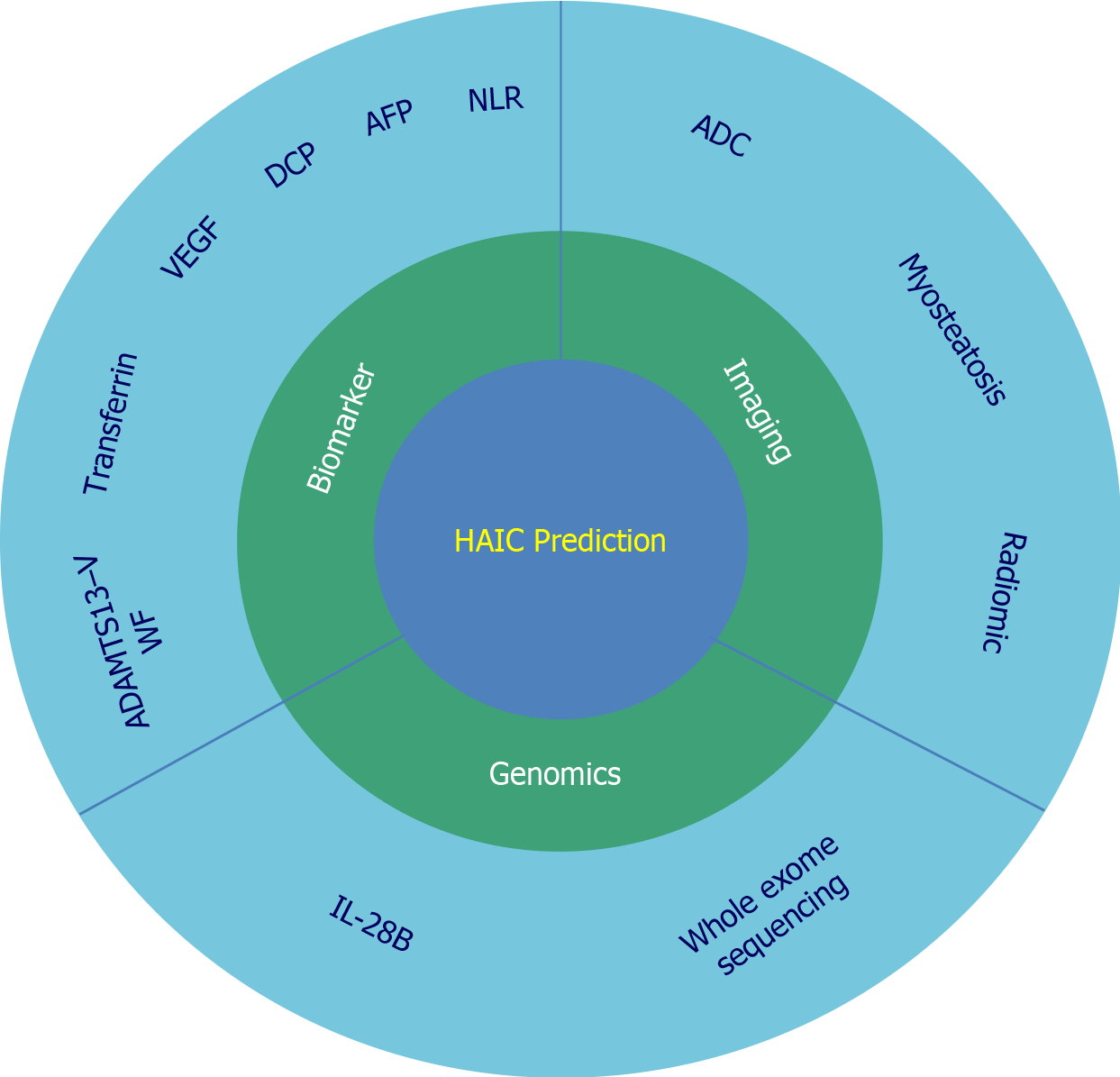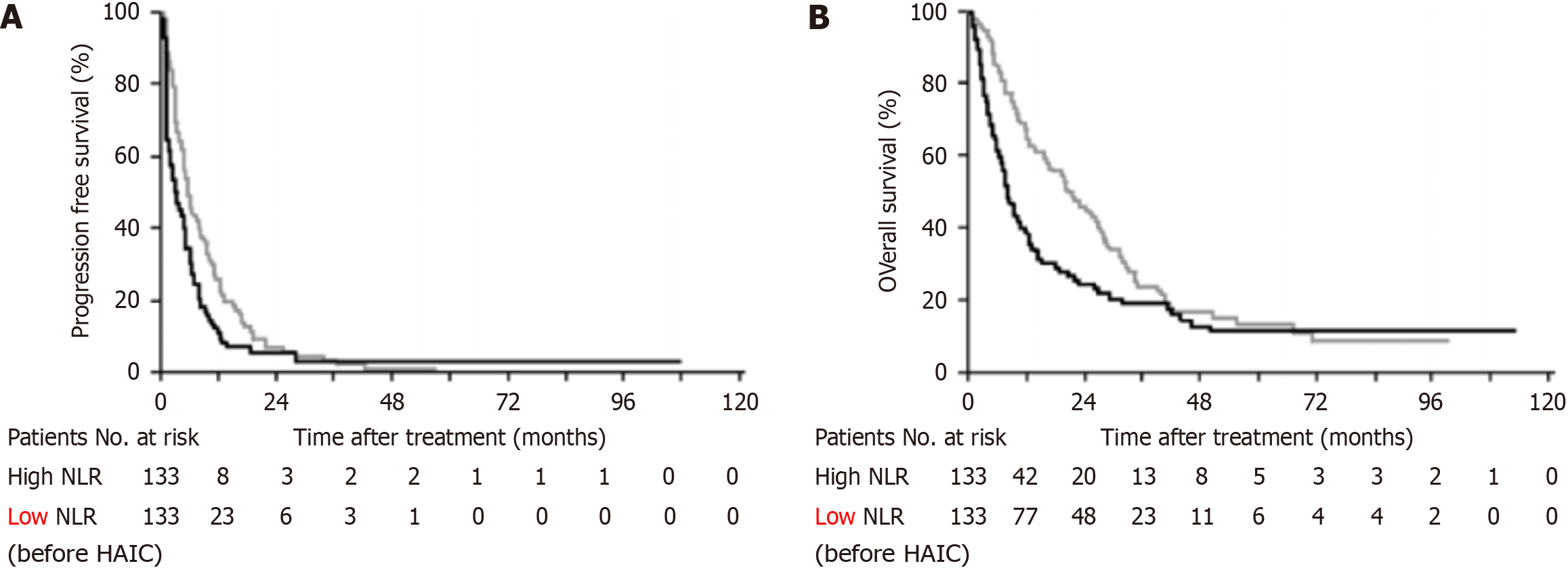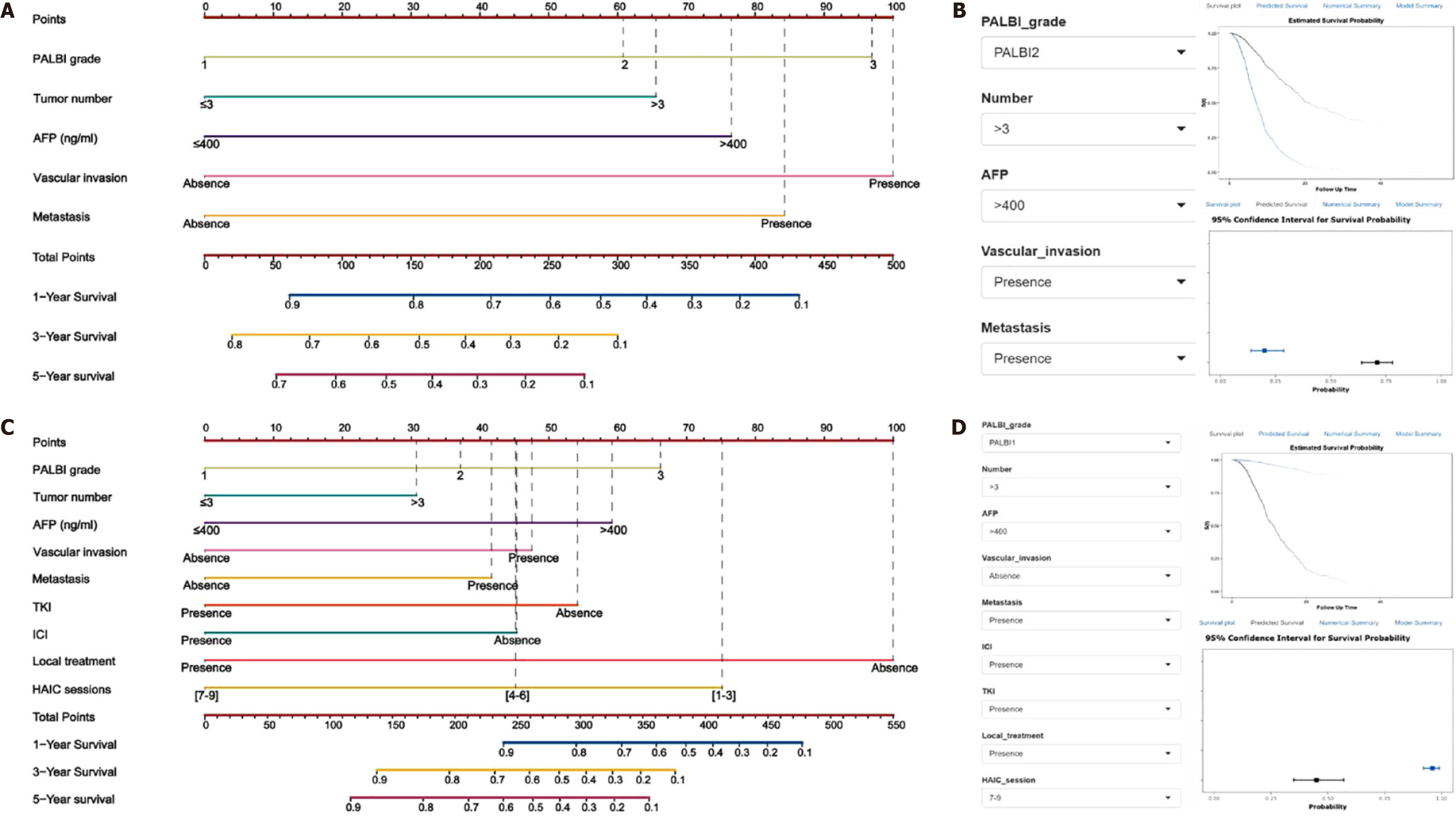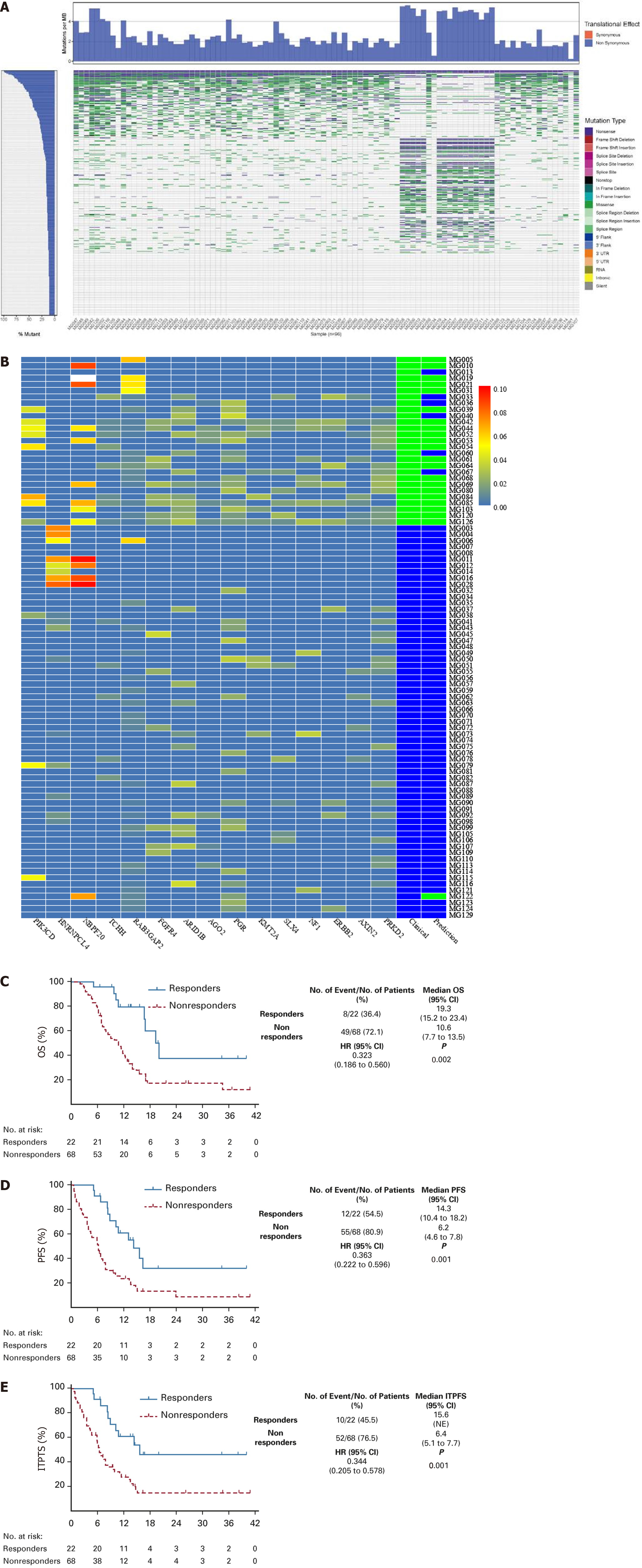Copyright
©The Author(s) 2024.
World J Gastrointest Oncol. Jun 15, 2024; 16(6): 2380-2393
Published online Jun 15, 2024. doi: 10.4251/wjgo.v16.i6.2380
Published online Jun 15, 2024. doi: 10.4251/wjgo.v16.i6.2380
Figure 1 A simplified scheme for the hepatic artery infusion chemotherapy prediction strategy.
Prognostic factors influencing hepatic arterial infusion chemotherapy for hepatocellular carcinoma, Such as biomarkers, imaging, and genomics. HAIC: Hepatic arterial infusion chemotherapy; NLR: Neutrophil to lymphocyte ratio; DCP: Des-γ-carboxy prothrombin; AFP: Alpha-fetoprotein; VEGF: Vascular endothelial growth factor; VWF: Willebrand factor; ADC: Apparent diffusion coefficient; IL-28B: Interleukin-28B.
Figure 2 Kaplan-Meier plot of progression-free survival and overall survival since commencement of hepatic arterial infusion chemotherapy according to neutrophil to lymphocyte ratio[31].
A: Median progression-free survival of the patients with high neutrophil to lymphocyte ratio (NLR) was 3.2 months, which was significantly worse than that of the patients with low NLR, 5.6 months (P < 0.01); B: Median overall survival of the patients with high NLR was 8.0 months, which was significantly worse than that of the patients with low NLR, 20.7 months (P < 0.01). Image, High NLR; image, Low NLR. Citation: Terashima T, Yamashita T, Iida N, Yamashita T, Nakagawa H, Arai K, Kitamura K, Kagaya T, Sakai Y, Mizukoshi E, Honda M, Kaneko S. Blood neutrophil to lymphocyte ratio as a predictor in patients with advanced hepatocellular carcinoma treated with hepatic arterial infusion chemotherapy. Hepatol Res 2015; 45: 949-959. Copyright © 2014. Published by John Wiley and Sons. The authors have obtained the permission for figure using (Supplementary material).
Figure 3 The prognostic in patients with hepatocellular carcinoma with different level of plasma ADAMTS13 and Von Willebrand factor receiving hepatic arterial infusion chemotherapy treatment[51].
A: ADAMTS13 levels were significantly higher in hepatocellular carcinoma patients receiving hepatic arterial infusion chemotherapy treatment with stable disease (SD) + partial response (PR) than in those with progressive disease (PD) (P < 0.05); B: Von Willebrand factor (VWF) antigen levels were not different between patients with SD + PR and PD; C: VWF/ADAMTS13 ratio was significantly lower in patients with SD + PR than in those with PD (P < 0.05). SD: Stable disease; PR: Partial response; PD: Progressive disease; ADAMTS13: A disintegrin-like and metalloproteinase with thrombospondin type 1 motifs 13; ADAMTS13:AC: ADAMTS13 activity; VWF: Von Willebrand factor; VWF:Ag: VWF antigen; VWF:Ag/ADAMTS13:AC ratio: Ratio of VWF:Ag to ADAMTS13:AC. Citation: Takaya H, Namisaki T, Moriya K, Shimozato N, Kaji K, Ogawa H, Ishida K, Tsuji Y, Kaya D, Takagi H, Fujinaga Y, Nishimura N, Sawada Y, Kawaratani H, Akahane T, Matsumoto M, Yoshiji H. Association between ADAMTS13 activity-VWF antigen imbalance and the therapeutic effect of HAIC in patients with hepatocellular carcinoma. World J Gastroenterol 2020; 26: 7232-7241. Copyright © The Author(s) 2020. Published by Baishideng Publishing Group Inc. The authors have obtained the permission for figure using (Supplementary material).
Figure 4 Development of prognostic models[57].
A: The Hepatic artery infusion chemotherapy (HAIC) nomogram was established using diagnostic factors for patients who had not received HAIC treatment and had preoperative HAIC data; B: The website for the pre-HAIC is available at https://prehaicnomogramforhcc.shinyapps.io/DynNomapp/; C: The post-HAIC nomogram was established using multiple factors for patients who had undergone HAIC treatment and had both preoperative and post-HAIC data; D: The website for post-HAICN is available at https://prehaicnomogramforhcc.shinyapps.io/postHAICN/. Citation: Yao W, Wei R, Jia J, Li W, Zuo M, Zhuo S, Shi G, Wu P, An C. Development and validation of prognostic nomograms for large hepatocellular carcinoma after HAIC. Ther Adv Med Oncol 2023; 15: 17588359231163845. Copyright © 2023. Published by SAGE Publications. The authors have obtained the permission for figure using (Supplementary material).
Figure 5 Workflow of the study[65].
A: Tumor segmentation on magnetic resonance images. Radiomic feature extraction from the volume of interest; B: The least absolute shrinkage and selection operator regression was applied to identify optimal radiomic features and construct the Rad-score; C: The nomogram model was established. The receiver-operator characteristic and calibration curves were constructed to assess the model performance. Citation: Zhao Y, Huang F, Liu S, Jian L, Xia X, Lin H, Liu J. Prediction of therapeutic response of unresectable hepatocellular carcinoma to hepatic arterial infusion chemotherapy based on pretherapeutic MRI radiomics and Albumin-Bilirubin score. J Cancer Res Clin Oncol 2023; 149: 5181-5192. Copyright © 2022 The Author(s). Published by Springer Nature. The authors have obtained the permission for figure using (Supplementary material).
Figure 6 Gene signature set predicts hepatic artery infusion chemotherapy response[76].
A: Mutational landscape of the total 96 patients' sequence data by the next-generation sequencing analysis (Each row represents a gene, each column represents a sample, and different colors represent types of mutations); B: Heatmap of the correlation of 15-gene model and tumor response to the hepatic artery infusion chemotherapy (HAIC) treatment in the total 96 patients underwent genomic sequencing (Row: One sample of the mutation of the chosen 15 polymorphic sites, Column: One polymorphic site of the 90 samples). The right two columns show the tumor response to the HAIC treatment (green: response; blue: non-response); C: Survival outcomes between the HAIC responders and the HAIC nonresponders identified by the 15- mutant-gene prediction model; C-E: Kaplan-Meier estimates of (C) overall survival, (D) progression-free survival, and (E) intrahepatic tumor progression-free survival (ITPFS). Citation: Lyu N, Wang X, Li JB, Lai JF, Chen QF, Li SL, Deng HJ, He M, Mu LW, Zhao M. Arterial Chemotherapy of Oxaliplatin Plus Fluorouracil Versus Sorafenib in Advanced Hepatocellular Carcinoma: A Biomolecular Exploratory, Randomized, Phase III Trial (FOHAIC-1). J Clin Oncol 2022; 40: 468-480. Copyright © 2022. Published by American Society of Clinical Oncology. The authors have obtained the permission for figure using (Supplementary material).
- Citation: Wang QF, Li ZW, Zhou HF, Zhu KZ, Wang YJ, Wang YQ, Zhang YW. Predicting the prognosis of hepatic arterial infusion chemotherapy in hepatocellular carcinoma. World J Gastrointest Oncol 2024; 16(6): 2380-2393
- URL: https://www.wjgnet.com/1948-5204/full/v16/i6/2380.htm
- DOI: https://dx.doi.org/10.4251/wjgo.v16.i6.2380














